Viennoiserie
Viennoiseries (French pronunciation: [vjɛnwazʁi], "things of Vienna") are baked goods made from a yeast-leavened dough in a manner similar to bread, or from puff pastry, but with added ingredients (particularly eggs, butter, milk, cream and sugar) giving them a richer, sweeter character, approaching that of pastry.[1] The dough is often laminated. Viennoiseries are typically eaten at breakfast or as snacks.
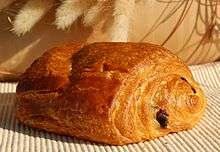 Pain au chocolat is a type of viennoiserie. | |
| Type | Pastry or bread |
|---|---|
| Course | Breakfast or snack |
| Place of origin | Austria |
| Main ingredients | Varies by type |
Types
Examples include: croissants; Vienna bread and its French equivalent, pain viennois, often shaped into baguettes; brioche; pain au chocolat; pain au lait; pain aux raisins; chouquettes; Danish pastries; xuixo; bugnes; and chausson aux pommes.
History
The popularity of Viennese-style baked goods in France began with the Viennese Bakery opened by August Zang in 1839. The first usage of the expression "pâtisseries viennoises" appears in a book by French author Alphonse Daudet, Le Nabab in 1877.[2] However the use of puff pastry came later and is a French, not Viennese, in method.[3]
Gallery

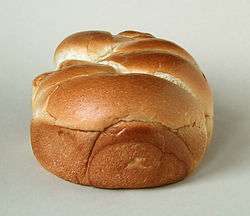
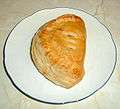

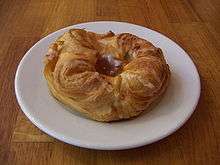
.jpg) Oranais
Oranais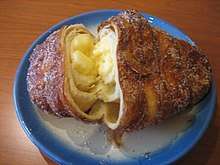
References
- Session expirée
- "Viennois, -oise (definition)". Centre National de Ressources Textuelles et Lexicales. Retrieved 19 June 2011.
- Chevallier, Jim; August Zang and the French Croissant: How Viennoiserie Came to France. Chez Jim Books
| Wikimedia Commons has media related to Viennoiseries. |